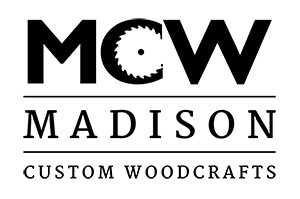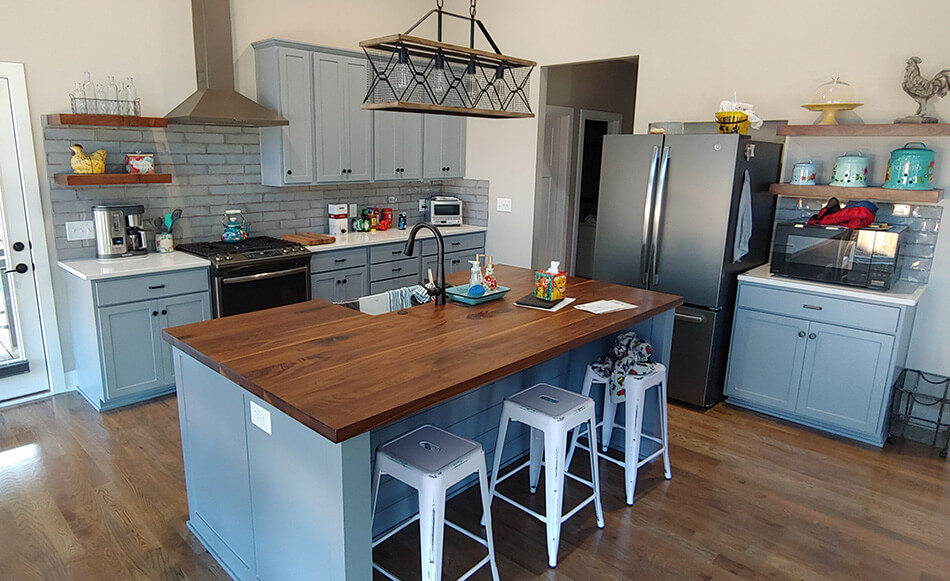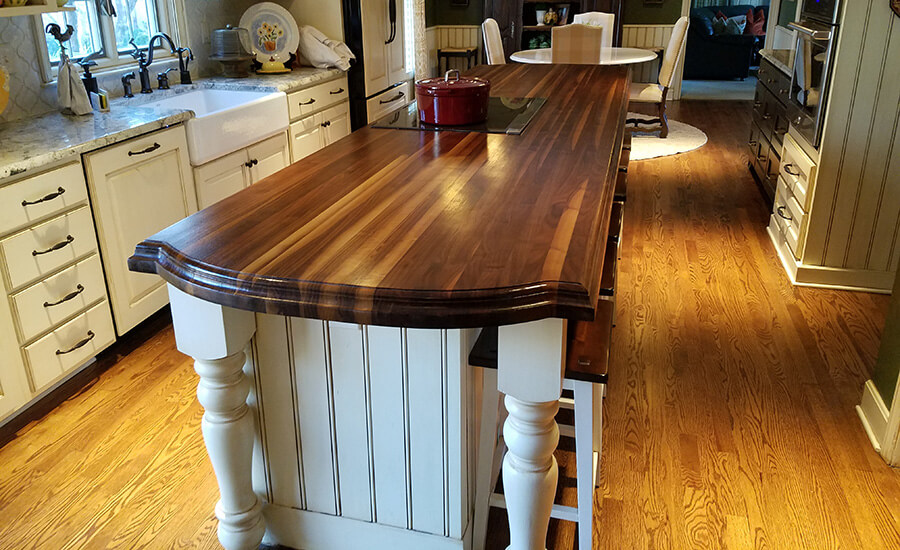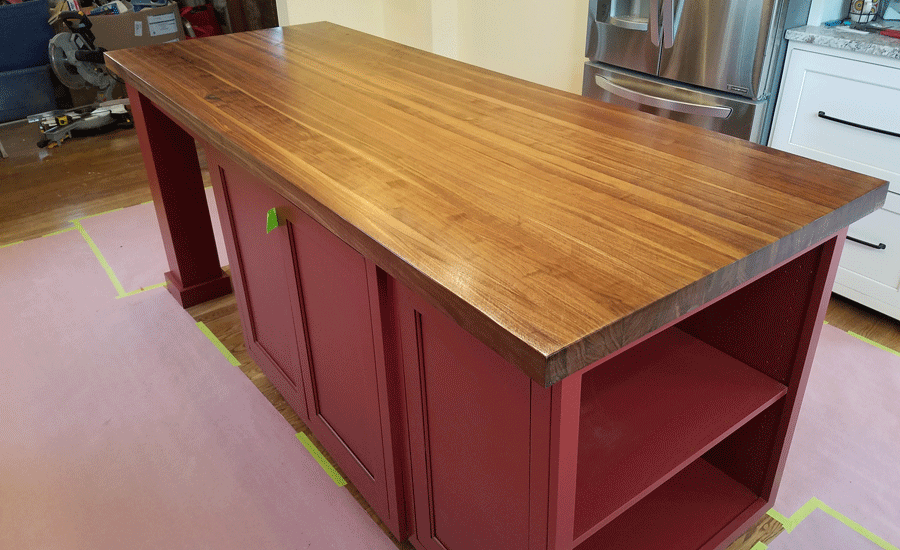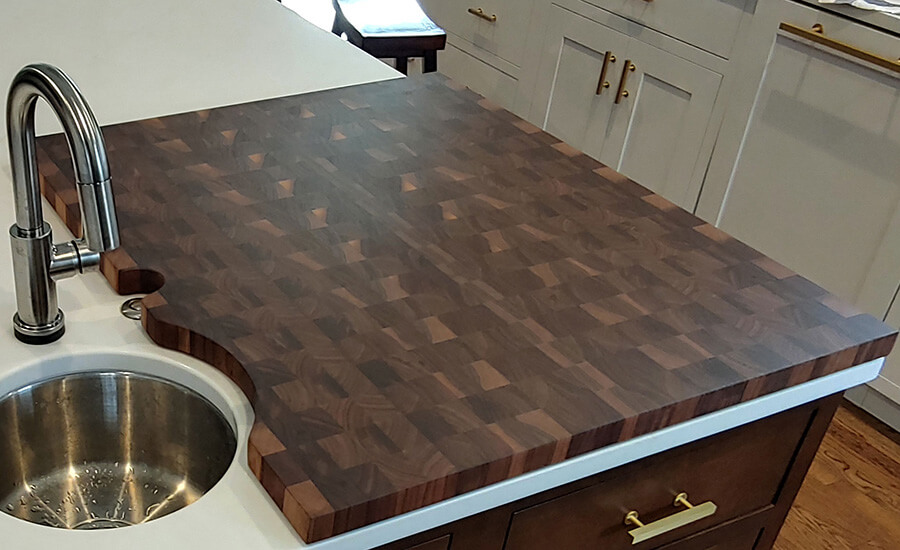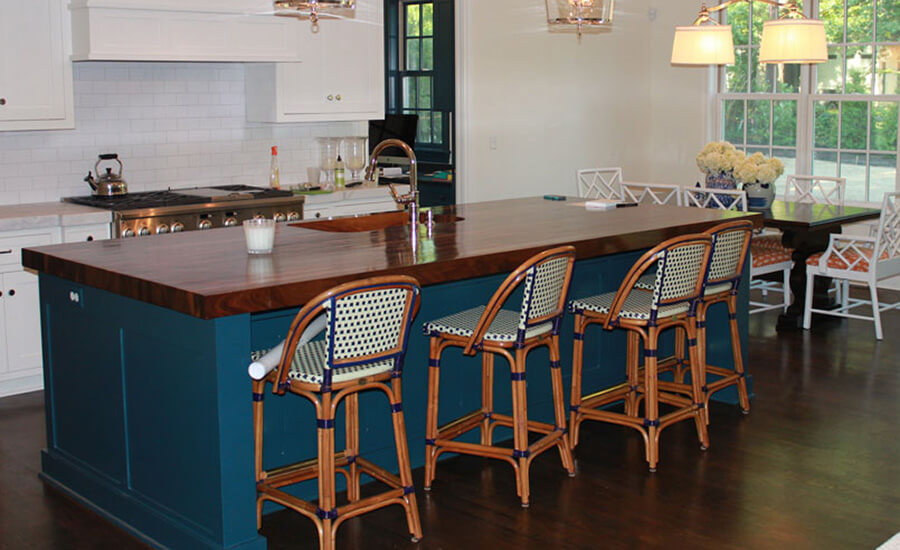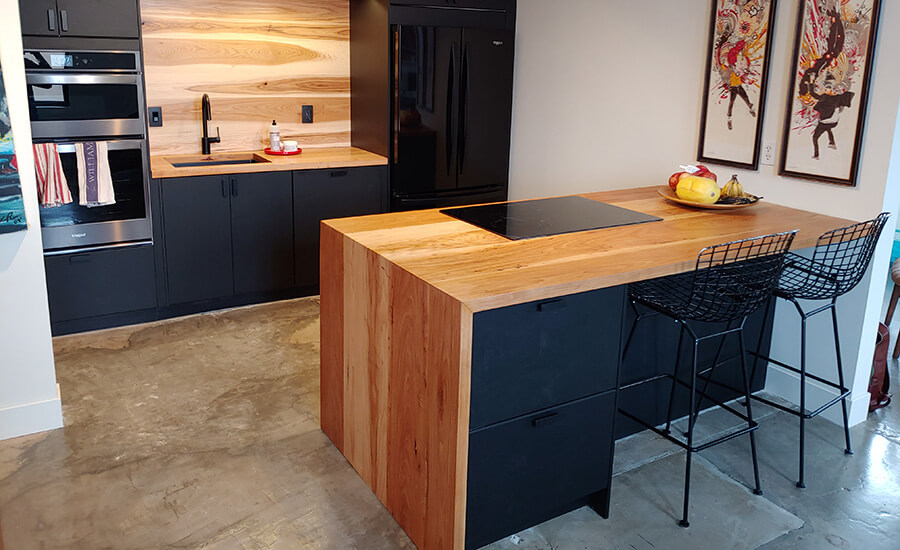Add Beauty to Your Kitchen With a Custom Wood Countertop
A beautiful, custom wood countertop will add warmth and unique character to your kitchen, bar, or bathroom. Individually handcrafted, our solid wood countertops are built to exploit the natural beauty of your chosen wood, and will contribute a striking ambiance to your home’s living spaces.
"Thank you so much for finding the walnut slab for the top shelf of our entertainment center. Exactly what I was looking for. I don’t know if you get many thanks, but thanks a lot for going the extra mile."
Alan | Olathe, KS
Why Choose a Solid Wood Countertop?
We work with you to design, construct, and install a wood countertop that is truly unique. Our wood countertops, island tops, and butcher blocks are available in a wide variety of natural hardwoods, construction styles, design styles, edge options, design options, and finishes.
Warm to the touch as compared to colder stone tops
Reduce breakage of glassware or other fragile items
Madison Custom Woodcraft’s lifetime guarantee
100% American-made quality
Handcrafted locally in Kansas City
The color and character of your wood countertop will improve with time
Suitable for all kitchen design styles including modern, traditional, contemporary, country, and Mediterannean
Create a one-of-a-kind piece with multiple color, wood, shape, and finish options
Muffle the sounds of clinking dishes, glassware, and kitchen appliances
Countertop Wood Types
Maple Wood
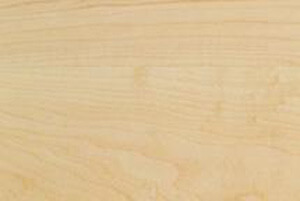
Used in traditional butcher blocks, maple wood possesses many excellent characteristics for this application. The grain of Maple is generally straight, with a fine, even texture. It is white to off-white cream in color.
Cherry Wood
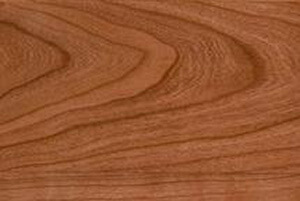
Hardwood known for its grain and for aging from a pinkish tone to a warm reddish hue. It has brown pith flecks and small gum pockets that accent the already appealing grain pattern. The color of Cherry is considered unique among the hardwoods.
Ash Wood
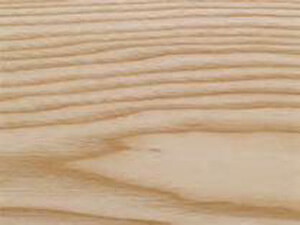
Domestic wood widely used in a variety of projects. Light-colored like Maple with coarser grain like Oak. Ash tends to darken as it ages.
Red Oak Wood
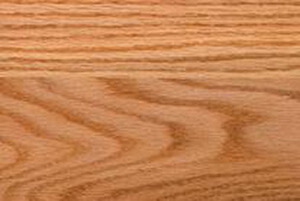
Red Oak is very strong and very hard with high durability and wear resistance. It is reddish in color and with dark, elongated grains and cathedrals. The grain lines provide a nice contrast to the color of the wood.
White Oak Wood
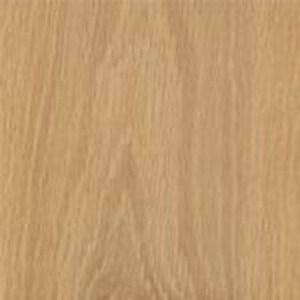
Heartwood is a light to medium brown, commonly with an olive cast. Nearly white to light brown sapwood is not always sharply demarcated from the heartwood. Quartersawn sections display prominent ray fleck patterns. Conversely, Red Oak tends to be slightly redder, but is by no means a reliable method of determining the type of oak. Grain is straight, with a coarse, uneven texture.
Walnut Wood
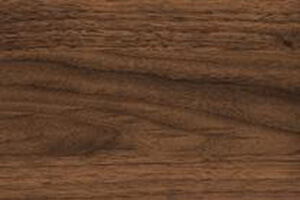
Walnut is a domestic hardwood that is attractive, tight-grained, and improves with age. Walnut is the only North American dark wood; its color is a dark chocolate brown. Its color also goes well with other wood species when choosing an end grain butcher block.
Hickory Wood
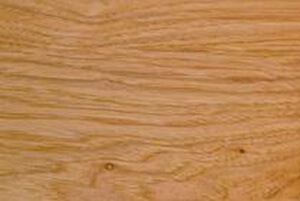
Domestic open-grained hardwood that is often used for rustic applications. The grain is generally straight and can range from blond to medium brown with a reddish hue. Hickory is denser, stiffer, and harder than either Oak or Maple.
Mahogany Wood
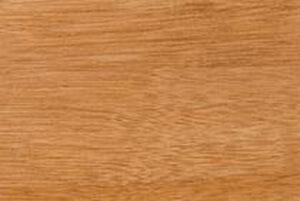
Mahogany has long been the choice in fine furniture and millwork. Mahogany wood countertops are a light to deep brown with a reddish hue. The grain is straight to interlocked, with medium to course texture.
Birch Wood
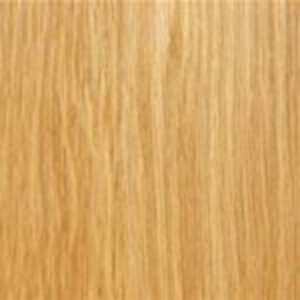
Birch tends to be a light reddish brown, with nearly white sapwood. Occasionally figured pieces are available with a wide, shallow curl similar to the curl found in Cherry. Grain is generally straight or slightly wavy, with a fine, even texture. Low natural luster.
Beech Wood
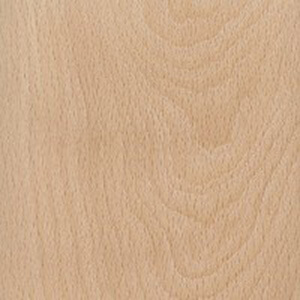
Beech is typically a pale cream color, sometimes with a pink or brown hue Flatsawn surfaces tend to be very plain, while quartersawn surfaces exhibit a silvery fleck pattern. Grain is straight, with a fine to medium uniform texture. Moderate natural luster.
Knotty Alder Wood
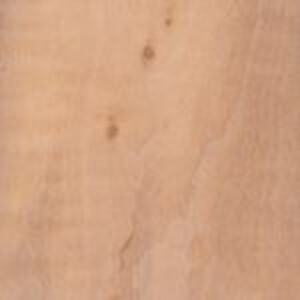
Alder tends to be a light tan to reddish brown; color darkens and reddens with age. There is no visible distinction between heartwood and sapwood. The overall grain pattern and appearance is like Birch -though redder than Birch. Alder has closed pores, and a fine, even grain. The grain is usually straight but can also be wild or irregular depending on the growth form of each individual tree.
Wood Hardness
The hardness of the wood can be a factor to consider when choosing the species of wood used for a countertop. We use select hardwoods and provide a comprehensive warranty, therefore the visual appeal of your design should take precedence. The Janka chart has been used as an industry standard for determining the hardness of woods. The hardness test is conducted on plank style construction, while edge grain construction will result in additional hardness. The hardness of the wood is only one element to consider while choosing the wood countertop or island top that is perfect for you. Listed below is the hardness of select species. species are suitable for countertops, so if you have something in mind that you don’t see here, please contact us. We are happy to work with you to find the best wood for your project.
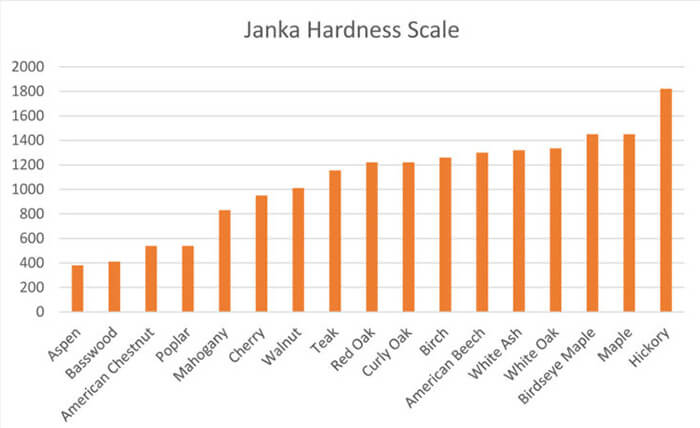
Wood Countertop Construction Styles
With a custom wood countertop, island top, or butcher block, you will need to select a construction style. Plank or face grain top are constructed with the face of the wood up to show the natural pattern of the grain. Edge grain tops are constructed with the side of the wood up, which shows the vertical lines of the grain. End grain or butcher block tops are constructed with the end of the wood up using squares or rectangular blocks.
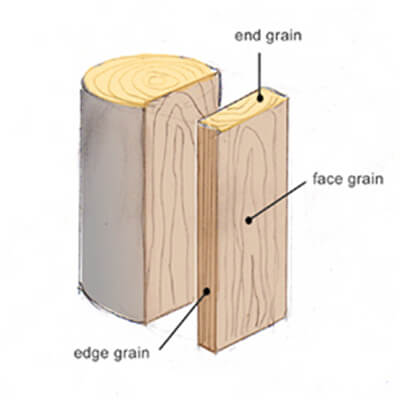
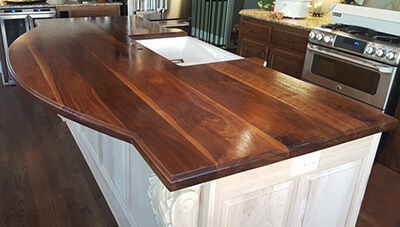
Face Grain (Plank)
Used in traditional butcher blocks, maple wood possesses many excellent characteristics for this application. The grain of Maple is generally straight, with a fine, even texture. It is white to off-white cream in color.
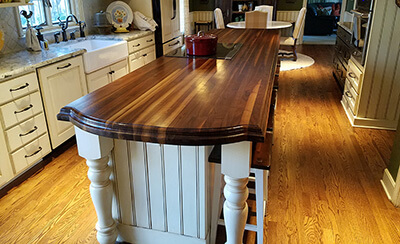
Edge Grain (Cutting Board)
Edge grain or cutting board countertops are constructed with the side of the wood up. Straight grain lines are most visible with this style. This method does not show the seasonal wood movement that the plank construction style shows. Edge grain countertops can be 1.25″ to 6″ thick. The strips may run the entire length of the top or randomly jointed.
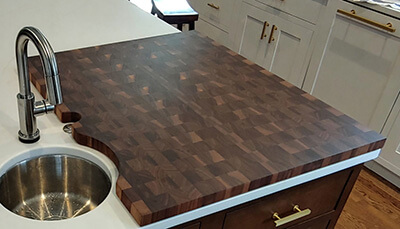
End Grain (Butcher Block)
Edge grain or cutting board countertops are constructed with the side of the wood up. Straight grain lines are most visible with this style. This method does not show the seasonal wood movement that the plank construction style shows. Edge grain countertops can be 1.25″ to 6″ thick. The strips may run the entire length of the top or randomly jointed.
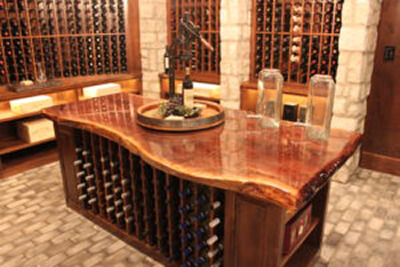
Slab
Live edged slabs incorporate the natural edge of the wood into the design of countertop. Live edge (also known as natural edge) wood is created by retaining the raw edge of the tree and allowing the natural shape to show through. The contour of the edge can range from wavy and undulating curves to sharp spikes. The natural edge preserves the character of the original tree ensuring that each edge is completely unique. With only it’s logmates sharing similar, but still not exact characteristics. The live edge countertops have the live edges along long sides of the top.
Countertop Design Features
Our tops are custom designed to meet your requirements and design style. We can incorporate any sink, stove, or faucet cutouts. Certain design features may be added to make the top stand out. We have several corner, front, and side options, including a live edge, for you to consider. We also provide corner joining options. We can incorporate steel reinforcement to allow for an overhang without any legs or brackets.
- Sinks, Ovens, Faucets
- Island Top Shapes
- Corner Options
- Waterfall Ends
- Edge Profiles
- Steel Reinforcement
- Bread Board Ends
- Back Splash
- Trivet Rods
- Drainage Channels
- Knife Storage
Sinks, Ovens, and Faucets
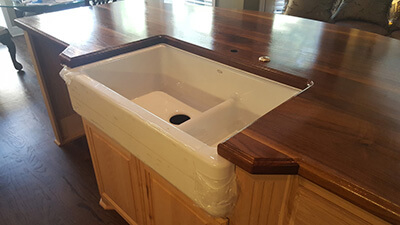
We can incorporate and size or shape cutout for sinks, ovens, and faucets. Sink and oven cutout are done at our shop, where we seal the exposed edges. The cutout can be done using drawings and the template provided by the sink manufacturer. Matching backsplashes are available for all countertops. Each backsplash is ¾” thick and 4” or 6” in height. The top edge can be eased or rounded over.
Island Top Shapes
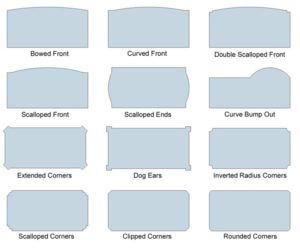
We have several corner, front, and side options for you to consider.
Corner Options
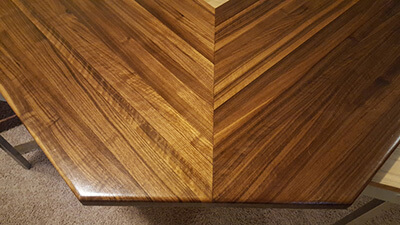
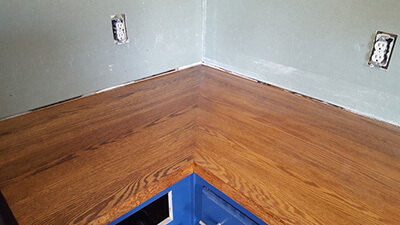
We can miter or flush joint a corner.
Waterfall Ends
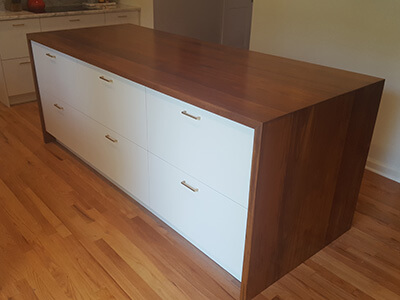
Edge Profiles
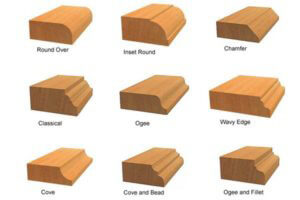
We offer the following standard edge profiles.
Steel Reinforcement
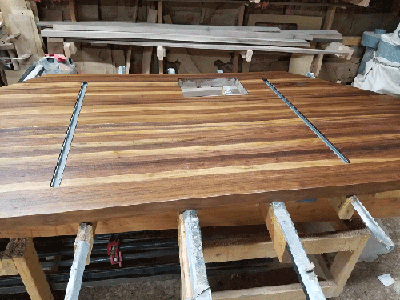
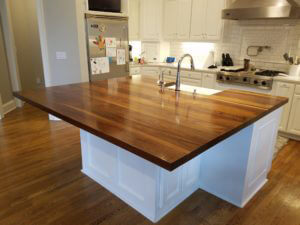
1″ x 1/2″ steel channel bars are installed within a routed channel to lay flat with the bottom of the top. These bars support the top in order allow for an open overhang.
Bread Board Ends
Breadboard ends are narrow pieces that are mechanically joined to the ends of a larger panel. The purpose is to support and maintain the rigidity of the panel, while allowing the panel to shrink or expand across the grain. The bread board end hides the ends of the longer boards in a plank style counter top.
Back Splash
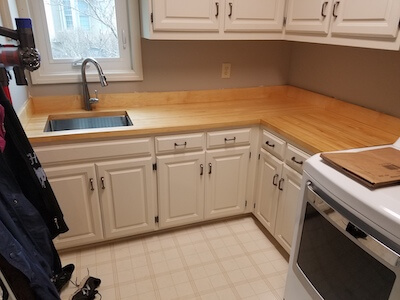
Matching backsplashes are available for all countertops. Each backsplash is ¾” thick and 4” or 6” in height. The top edge can be eased or rounded over.
Trivet Rods
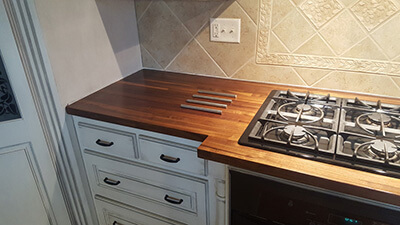
Trivet rods are 5/8” stainless steel rods that fit into groves in the top. The rods allow hot pots and pans to be placed on the top without damaging the wood. The rods sit 3/8” above the countertop surface. The rods can be arranged in several different patterns.
Drainage Channels
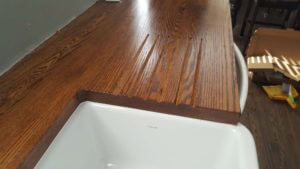
Drainage channels can be machined into the top for drainage into a sink. The channels are bull nose grooves that slope toward the sink. The location, spacing, and design can be custom to each countertop.
Knife Storage
Knife storage can take the form of a singular long slot, series of slots, or a removable knife block. A long singular knife slot can be placed so the knives fit in the gap between the two cabinets below. Careful attention should be paid to placing knife slots above drawers, as the knives can interfere with the drawers below. Knife slots that are one long singular slot will fit a more universal set of knives. Removable knife blocks can be replaced with another piece when your knife set changes. Each removable knife block can be designed to any shape or size desired.
Countertop Finishes
The type of finish is dependent upon the intended use of the countertop. All finishes that we use are safe for food contact. Mineral oil or a mineral oil and beeswax mix is used for countertops where the top is intended to be used as cutting board. This finish will wear and need to be reapplied regularly. For countertops, bar tops, and wood bathroom tops where a permanent waterproof finish is required, we use Waterlox® or 2k polyurethane.
Mineral Oil
Mineral oil is one common food-safe oil that is used to treat wood countertops, but it offers limited protection from water. Oiled surfaces provide some protection to the wood and keep it from drying out, warping or cracking. A wax and/or wax and oil combination offers the same benefits. A mineral oil surface will not protect a wood countertop from long term exposure or consistent wetness. Mineral Oil finishes and wax finishes will need to be renewed periodically to maintain the protection of the wood.
2K Polyurethane
2k polyurethane is extremely durable, two component acrylic polyurethane that is GREENGUARD Certified and offers exceptional high build and clarity, excellent chemical and mar resistance, true non-yellowing performance and a full range of sheens. POLARION Interior clear high solids, water white formula was specifically designed for interior wood surfaces that are exposed to moisture, heat and household chemicals. It can be used for interior wood surfaces that require a hard durable finish. Meets AWI specifications for polyurethane chemical resistance. Meets KCMA specifications for withstanding substances typically found in kitchens and bathrooms. Contact and dry time of each chemical is in accordance with AWI and KCMA test procedures.
Waterlox
Waterlox Original Tung Oil products are resin-modified tung oil-based wood finishes. The tung oil provides the best penetrating and drying qualities available while the resin allows the coatings to form a film that is both water-resistant and elastic.
Different from other types of wood finishes, Waterlox offers “best of both worlds” benefits. For example, raw oils penetrate into wood but do not provide any real protection to the substrate. Plus, raw oil finishes need to be recoated often. Urethane coatings lay on top of the surface, look more like plastic, can be brittle and once breached ultimately fail. Waterlox is truly incomparable because it penetrates like raw oil, while protecting and nurturing the wood without becoming fragile or having a plastic appearance.
Waterlox finishes penetrate into the pores of the wood and build up to a coating that both guards and strengthens the wood. Best of all, they are easier to restore and re-coat.
Distressing
For a worn or country feel we use several different techniques. We can incorporate saw marks, worm holes and other marks.
Staining
We offer a wide spectrum of stain colors. We can also match any stain color that you prefer. The stains available are dependent upon the choice of wood species.
Frequently Asked Questions
Are wood countertops a good option?
Wood countertops are a consistently good choice for the modern kitchen and come with a variety of advantages. From aesthetics to durability, let us educate you on the best wood and why it might be the right choice for you.
What is the thickness of wood countertops?
Plank style wood countertops have a thickness of one to two inches. A thicker wood material can be custom made if necessary.
The most common thicknesses for edge grain countertops are one and a quarter inches, one and one-half inches, two inches, and three inches. The most durable wood countertops are made of one and a quarter thick strips that are glued together.
End grain chopping blocks can be a thickness of three inches to 12 inches. The most commonly ordered chopping blocks are those with a thickness of three or four inches.
How Are Wood Countertops Made?
The structure of wood countertops is made up of the hardest and most durable part of premium wood. The slats are glued with premium wood glue and are also bolted for strength and resistance to cracks.
What is the best construction style for cutting or chopping?
The best construction style for cutting or chopping is end grain construction, which is far more forgiving on knife edges and does not readily show knife marks. Rather than cutting across the grains of wood, end grain construction allows the blade to slide between the grains of wood, keeping the blade honed far longer than other cutting surfaces. End Grain construction is incredibly durable, stylish and functional.
Is wood safe to use as cutting surface?
Yes, wood is perfectly safe to use for cutting or chopping. In fact, studies have shown that wood is actually safer to use than plastic. Research indicates that bacteria, such as the salmonella often found on raw chicken, will thrive and multiply if not removed from plastic boards. On both new and used wood cutting surfaces, the bacteria dies off within 3 minutes. Researchers theorize that the porous surface of the wood deprives the bacteria of water, causing them to die.
Why should I choose you for my wood countertop?
We strive to bring the highest quality to everything we do, from our Customer interactions to the construction and delivery of our wood tops. Each custom-built top utilizes the best possible raw materials, and our skilled craftsman labors over every detail, from the initial wood selection to the final finishing process.
We understand that you want a one-of-a kind product for your home. We work with each of our Customers individually to offer them a finished product that reflects their personal tastes and preferences. Not only that, but we stand behind every product we make with a lifetime warranty.
Can I put hot pans directly on the surface of my wood top?
Hot pots or pans should not be placed on the surface of a wood top. The heat can burn the wood, steam glue joints, cause cracking, or create bubbles in the permanent finish. For customers with a cooktop in or near their wood top, we offer integrated trivets as an optional feature. The trivets make the ideal resting place for hot pots and pans, and are completely removable and dishwasher safe.
We understand that you want a one-of-a kind product for your home. We work with each of our Customers individually to offer them a finished product that reflects their personal tastes and preferences. Not only that, but we stand behind every product we make with a lifetime warranty.
Can I cut or chop on a top that includes the Waterlox permanent finish?
The Waterlox finish should not be used for cutting or chopping. Cutting will leave knife marks and destroy the surface over time. The surface is perfectly suitable for rolling dough, pasta, or other similar food preparation activities. If you intend to use the surface for cutting or chopping, though, we recommend a mineral oil finish.
Will my wood top withstand water and stains?
Tops with Waterlox finish are water resistant, stain resistant, and chemical resistant. It is ideal for applications that include overmount or undermount sinks. Tops finished with mineral oil will need regular maintenance, and standing water should be avoided. Spills should be wiped up immediately to avoid staining.
How often do I need to re-oil my top?
Tops finished with mineral oil will need to be re-oiled approximately once per month, depending on use. Heavily used tops may require more frequent oiling. Simply coat the top lightly with oil using a paper towel or rag, allow the wood to absorb the oil for 5 – 10 minutes, and then wipe off any excess oil.
How should I maintain and care for my butcher block countertop?
Download our Butcher Block Care and Maintenance Guide for more information.
Do I need to worry about my wood countertop or butcher block harboring bacteria?
No, in addition to adding warmth and beauty to your kitchen, hardwood surfaces are extremely durable and hardwearing. Wood countertops and butcher block countertops are antimicrobial and do not harbor the growth of germs, molds, or mildew.
Do I need to worry about my wood countertop or butcher block warping?
Wood is a natural product subject to changes in humidity and temperature. Our countertops are finished on both the top and the bottom to limit the changes. Generally speaking, the humidity in one’s home does not fluctuate greatly enough to cause a finished top to warp beyond repair.
Do I need to worry about my wood countertop or butcher block cracking?
They can develop small cracks or checks over time. This is a natural wood process and is not considered to be a defect. They rarely result in structural problems and, if desired can be easily repaired.
Can I have an undermount sink with wood countertops?
Yes, our countertops that are sealed with Waterlox will protect against water damage.
How long does it take to receive a wood countertop or butcher block?
Most pieces are completed 4-6 weeks after the deposit has been received. Timing can vary with intricate and more complicated pieces. There is a rush service available for an additional charge.
What is the most durable type of wood for countertops and butcher blocks?
All hardwood species are durable in their own way and will last a lifetime, taking on a character all their own.
Do wood counter tops scratch?
Wood counters are scratch resistant but can still be scratched, like any other counter material, by steel and other hard items.
Is there a lot of maintenance?
Depending on the finish and how you use your counters, they can be completely maintenance free or require very little.
How do you clean and care for wood counter tops?
Mild soap is the best cleaner used with a damp cloth, or a 20% vinegar and water solution. Vinegar will disinfect the countertop and will not harm the finish. Never use cleaners containing ammonia.
Download our Wood Countertop Care and Maintenance Guide for more information.
